Corporate Social Responsibility Report: Primark's Business Practices
VerifiedAdded on 2019/09/20
|20
|4560
|290
Report
AI Summary
This report provides a comprehensive analysis of Primark's Corporate Social Responsibility (CSR) initiatives, project management plan, and overall business strategies. It begins with an introduction to CSR, outlining its importance in ethical business conduct and stakeholder engagement, and then focuses on Primark's specific aims and objectives, including quality standards, environmental safety, and labor practices. The report delves into Primark's project management plan, detailing the initiating, planning, and control processes, along with a work breakdown structure and Gantt chart. The research methodology employs both qualitative and quantitative methods, including survey data and statistical analysis of sales, production costs, and customer growth before and after implementing CSR approaches. The report highlights the benefits of CSR, such as increased brand trust, sales, and efficiency, and discusses Primark's efforts to comply with ethical and sustainable practices. The report also includes data on the company's financial performance, including sales and profit margins, alongside customer satisfaction metrics. The report concludes with an assessment of Primark's supplier assessment and the overall impact of its CSR strategy on its business.
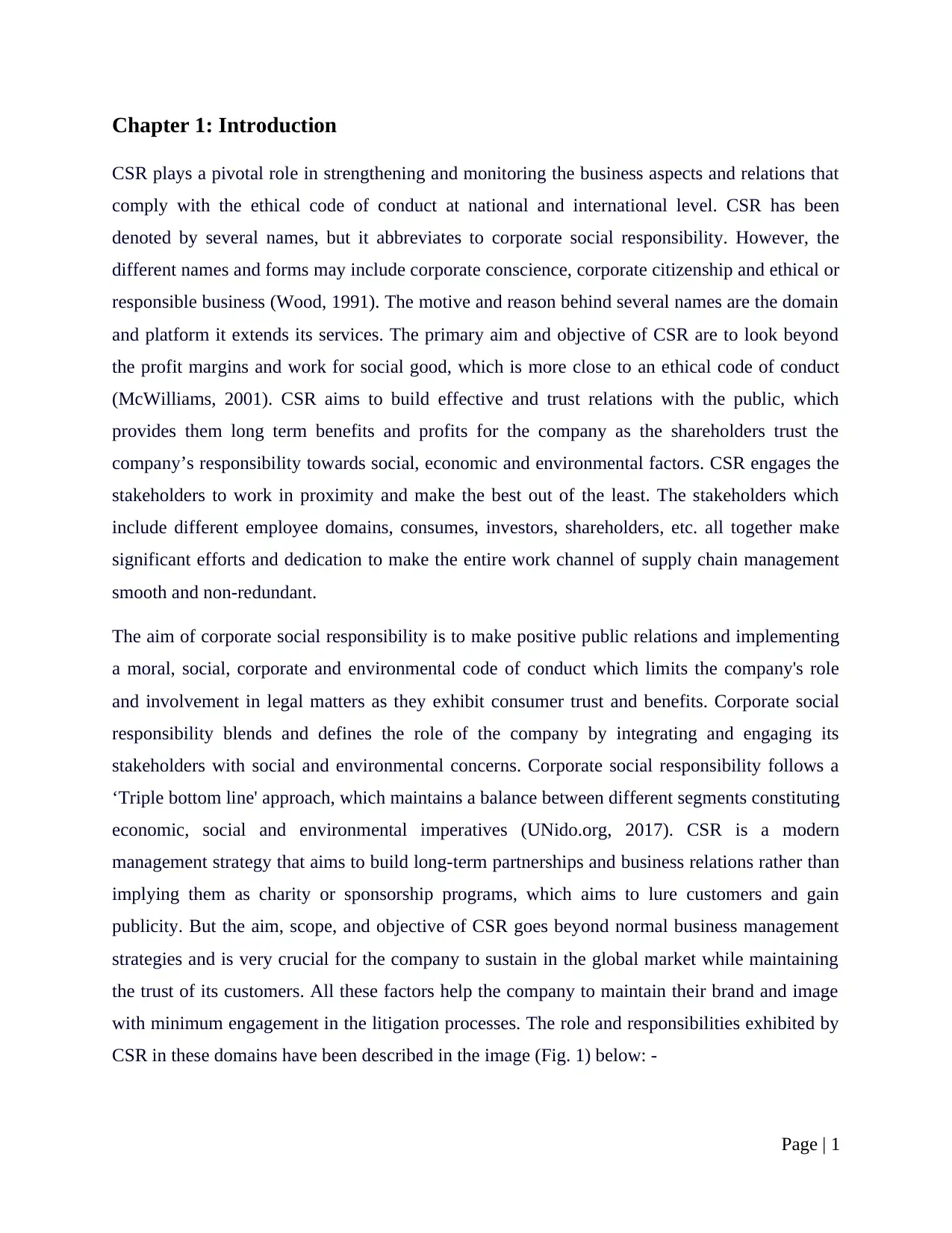
Chapter 1: Introduction
CSR plays a pivotal role in strengthening and monitoring the business aspects and relations that
comply with the ethical code of conduct at national and international level. CSR has been
denoted by several names, but it abbreviates to corporate social responsibility. However, the
different names and forms may include corporate conscience, corporate citizenship and ethical or
responsible business (Wood, 1991). The motive and reason behind several names are the domain
and platform it extends its services. The primary aim and objective of CSR are to look beyond
the profit margins and work for social good, which is more close to an ethical code of conduct
(McWilliams, 2001). CSR aims to build effective and trust relations with the public, which
provides them long term benefits and profits for the company as the shareholders trust the
company’s responsibility towards social, economic and environmental factors. CSR engages the
stakeholders to work in proximity and make the best out of the least. The stakeholders which
include different employee domains, consumes, investors, shareholders, etc. all together make
significant efforts and dedication to make the entire work channel of supply chain management
smooth and non-redundant.
The aim of corporate social responsibility is to make positive public relations and implementing
a moral, social, corporate and environmental code of conduct which limits the company's role
and involvement in legal matters as they exhibit consumer trust and benefits. Corporate social
responsibility blends and defines the role of the company by integrating and engaging its
stakeholders with social and environmental concerns. Corporate social responsibility follows a
‘Triple bottom line' approach, which maintains a balance between different segments constituting
economic, social and environmental imperatives (UNido.org, 2017). CSR is a modern
management strategy that aims to build long-term partnerships and business relations rather than
implying them as charity or sponsorship programs, which aims to lure customers and gain
publicity. But the aim, scope, and objective of CSR goes beyond normal business management
strategies and is very crucial for the company to sustain in the global market while maintaining
the trust of its customers. All these factors help the company to maintain their brand and image
with minimum engagement in the litigation processes. The role and responsibilities exhibited by
CSR in these domains have been described in the image (Fig. 1) below: -
Page | 1
CSR plays a pivotal role in strengthening and monitoring the business aspects and relations that
comply with the ethical code of conduct at national and international level. CSR has been
denoted by several names, but it abbreviates to corporate social responsibility. However, the
different names and forms may include corporate conscience, corporate citizenship and ethical or
responsible business (Wood, 1991). The motive and reason behind several names are the domain
and platform it extends its services. The primary aim and objective of CSR are to look beyond
the profit margins and work for social good, which is more close to an ethical code of conduct
(McWilliams, 2001). CSR aims to build effective and trust relations with the public, which
provides them long term benefits and profits for the company as the shareholders trust the
company’s responsibility towards social, economic and environmental factors. CSR engages the
stakeholders to work in proximity and make the best out of the least. The stakeholders which
include different employee domains, consumes, investors, shareholders, etc. all together make
significant efforts and dedication to make the entire work channel of supply chain management
smooth and non-redundant.
The aim of corporate social responsibility is to make positive public relations and implementing
a moral, social, corporate and environmental code of conduct which limits the company's role
and involvement in legal matters as they exhibit consumer trust and benefits. Corporate social
responsibility blends and defines the role of the company by integrating and engaging its
stakeholders with social and environmental concerns. Corporate social responsibility follows a
‘Triple bottom line' approach, which maintains a balance between different segments constituting
economic, social and environmental imperatives (UNido.org, 2017). CSR is a modern
management strategy that aims to build long-term partnerships and business relations rather than
implying them as charity or sponsorship programs, which aims to lure customers and gain
publicity. But the aim, scope, and objective of CSR goes beyond normal business management
strategies and is very crucial for the company to sustain in the global market while maintaining
the trust of its customers. All these factors help the company to maintain their brand and image
with minimum engagement in the litigation processes. The role and responsibilities exhibited by
CSR in these domains have been described in the image (Fig. 1) below: -
Page | 1
Paraphrase This Document
Need a fresh take? Get an instant paraphrase of this document with our AI Paraphraser
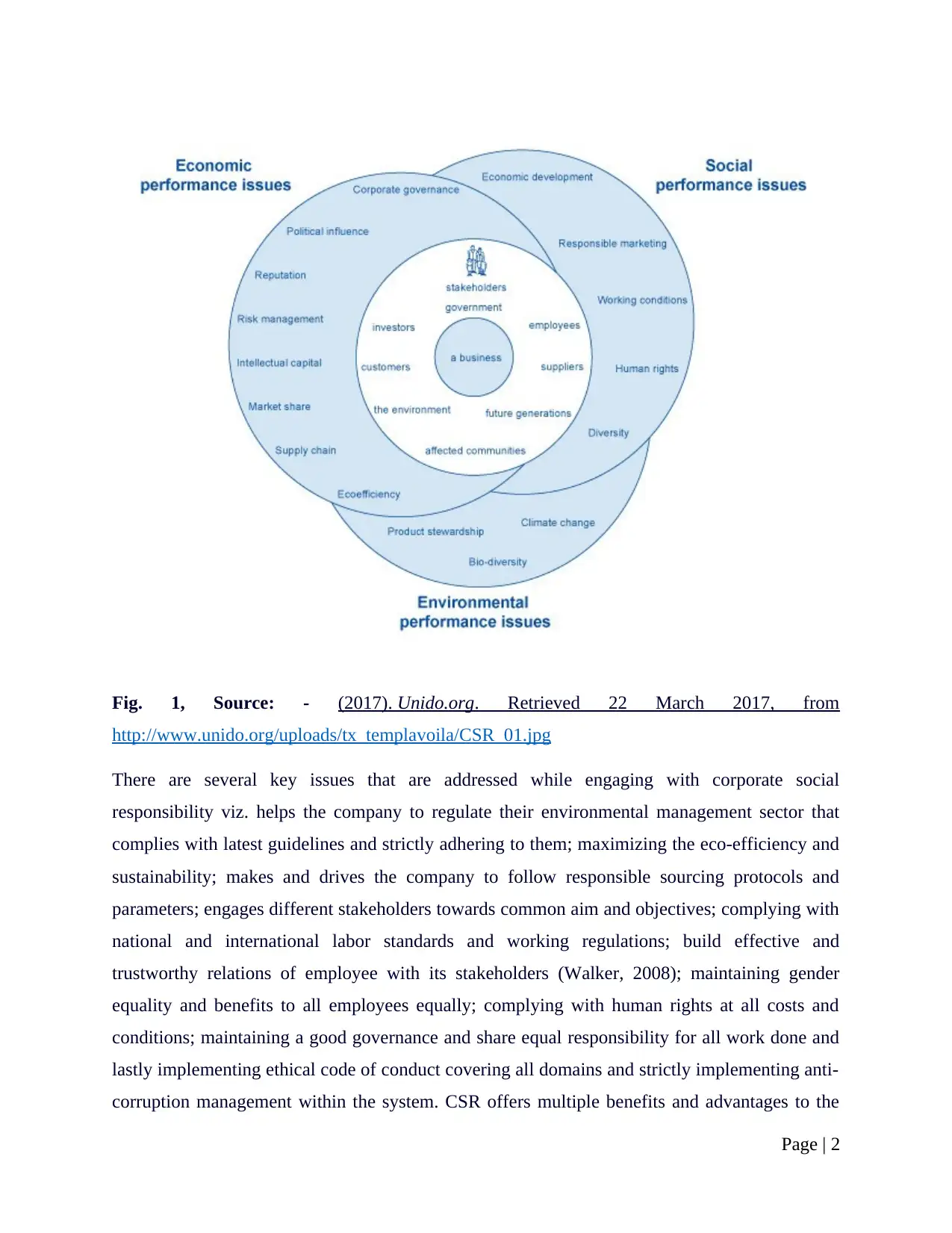
Fig. 1, Source: - (2017). Unido.org. Retrieved 22 March 2017, from
http://www.unido.org/uploads/tx_templavoila/CSR_01.jpg
There are several key issues that are addressed while engaging with corporate social
responsibility viz. helps the company to regulate their environmental management sector that
complies with latest guidelines and strictly adhering to them; maximizing the eco-efficiency and
sustainability; makes and drives the company to follow responsible sourcing protocols and
parameters; engages different stakeholders towards common aim and objectives; complying with
national and international labor standards and working regulations; build effective and
trustworthy relations of employee with its stakeholders (Walker, 2008); maintaining gender
equality and benefits to all employees equally; complying with human rights at all costs and
conditions; maintaining a good governance and share equal responsibility for all work done and
lastly implementing ethical code of conduct covering all domains and strictly implementing anti-
corruption management within the system. CSR offers multiple benefits and advantages to the
Page | 2
http://www.unido.org/uploads/tx_templavoila/CSR_01.jpg
There are several key issues that are addressed while engaging with corporate social
responsibility viz. helps the company to regulate their environmental management sector that
complies with latest guidelines and strictly adhering to them; maximizing the eco-efficiency and
sustainability; makes and drives the company to follow responsible sourcing protocols and
parameters; engages different stakeholders towards common aim and objectives; complying with
national and international labor standards and working regulations; build effective and
trustworthy relations of employee with its stakeholders (Walker, 2008); maintaining gender
equality and benefits to all employees equally; complying with human rights at all costs and
conditions; maintaining a good governance and share equal responsibility for all work done and
lastly implementing ethical code of conduct covering all domains and strictly implementing anti-
corruption management within the system. CSR offers multiple benefits and advantages to the
Page | 2
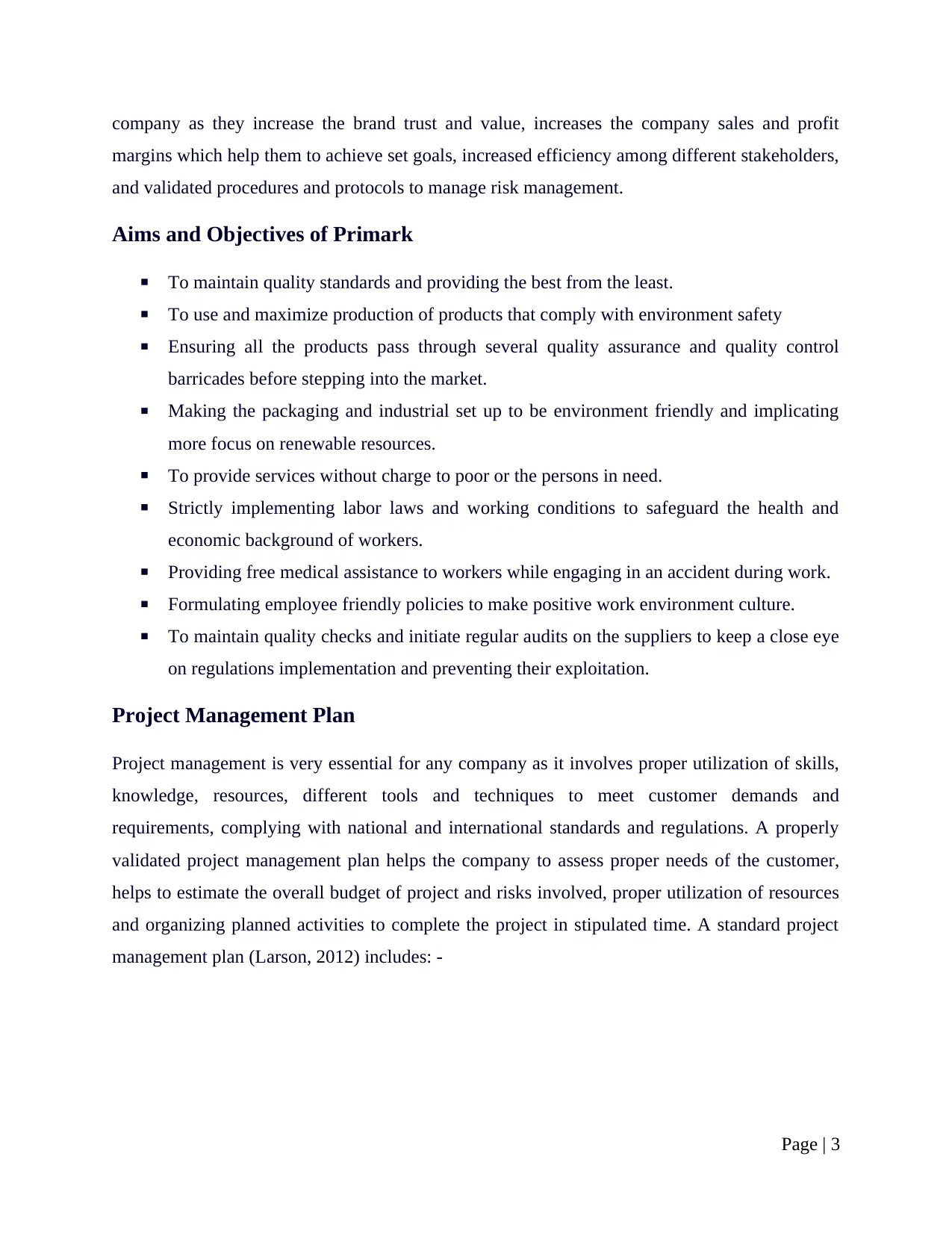
company as they increase the brand trust and value, increases the company sales and profit
margins which help them to achieve set goals, increased efficiency among different stakeholders,
and validated procedures and protocols to manage risk management.
Aims and Objectives of Primark
To maintain quality standards and providing the best from the least.
To use and maximize production of products that comply with environment safety
Ensuring all the products pass through several quality assurance and quality control
barricades before stepping into the market.
Making the packaging and industrial set up to be environment friendly and implicating
more focus on renewable resources.
To provide services without charge to poor or the persons in need.
Strictly implementing labor laws and working conditions to safeguard the health and
economic background of workers.
Providing free medical assistance to workers while engaging in an accident during work.
Formulating employee friendly policies to make positive work environment culture.
To maintain quality checks and initiate regular audits on the suppliers to keep a close eye
on regulations implementation and preventing their exploitation.
Project Management Plan
Project management is very essential for any company as it involves proper utilization of skills,
knowledge, resources, different tools and techniques to meet customer demands and
requirements, complying with national and international standards and regulations. A properly
validated project management plan helps the company to assess proper needs of the customer,
helps to estimate the overall budget of project and risks involved, proper utilization of resources
and organizing planned activities to complete the project in stipulated time. A standard project
management plan (Larson, 2012) includes: -
Page | 3
margins which help them to achieve set goals, increased efficiency among different stakeholders,
and validated procedures and protocols to manage risk management.
Aims and Objectives of Primark
To maintain quality standards and providing the best from the least.
To use and maximize production of products that comply with environment safety
Ensuring all the products pass through several quality assurance and quality control
barricades before stepping into the market.
Making the packaging and industrial set up to be environment friendly and implicating
more focus on renewable resources.
To provide services without charge to poor or the persons in need.
Strictly implementing labor laws and working conditions to safeguard the health and
economic background of workers.
Providing free medical assistance to workers while engaging in an accident during work.
Formulating employee friendly policies to make positive work environment culture.
To maintain quality checks and initiate regular audits on the suppliers to keep a close eye
on regulations implementation and preventing their exploitation.
Project Management Plan
Project management is very essential for any company as it involves proper utilization of skills,
knowledge, resources, different tools and techniques to meet customer demands and
requirements, complying with national and international standards and regulations. A properly
validated project management plan helps the company to assess proper needs of the customer,
helps to estimate the overall budget of project and risks involved, proper utilization of resources
and organizing planned activities to complete the project in stipulated time. A standard project
management plan (Larson, 2012) includes: -
Page | 3
⊘ This is a preview!⊘
Do you want full access?
Subscribe today to unlock all pages.

Trusted by 1+ million students worldwide
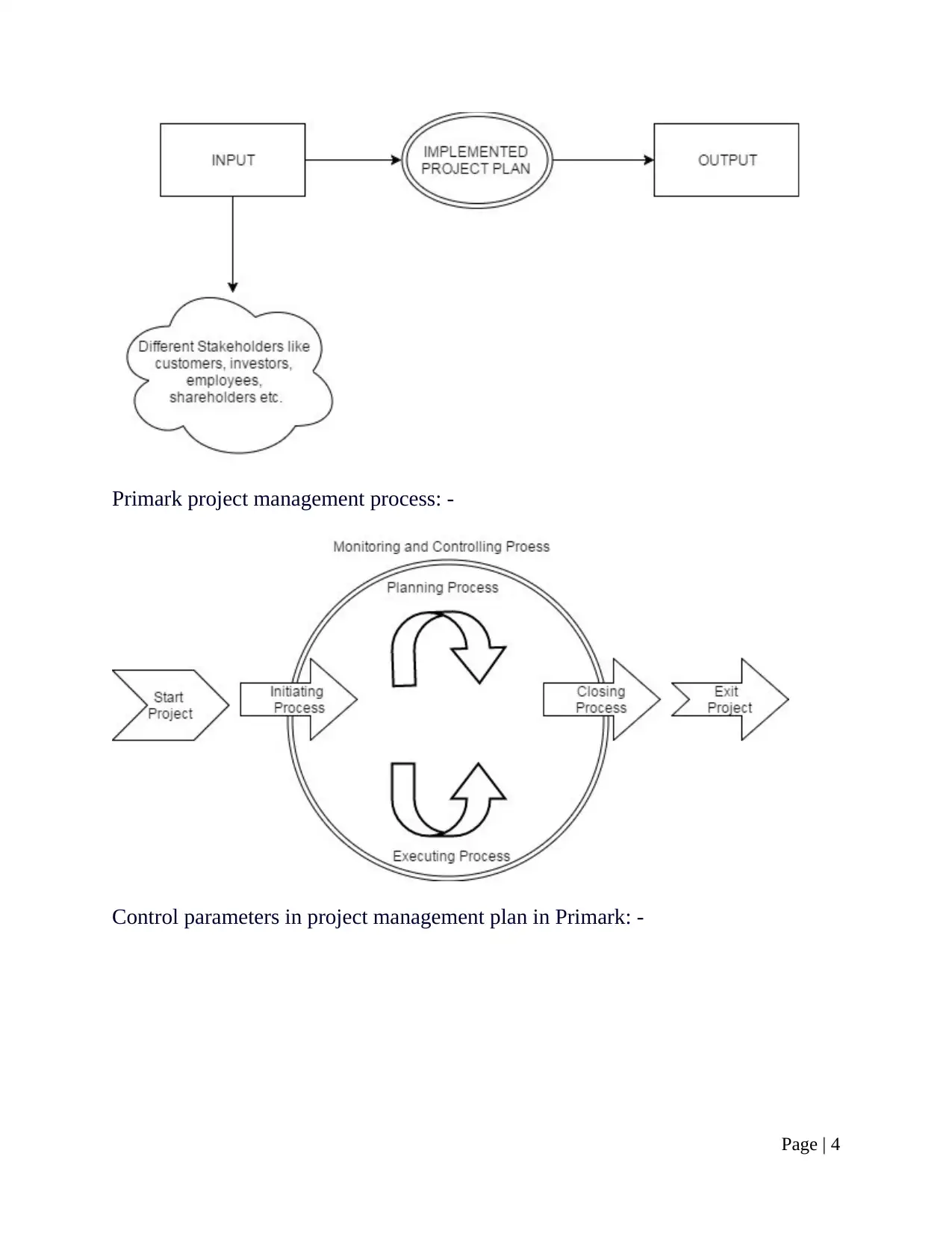
Primark project management process: -
Control parameters in project management plan in Primark: -
Page | 4
Control parameters in project management plan in Primark: -
Page | 4
Paraphrase This Document
Need a fresh take? Get an instant paraphrase of this document with our AI Paraphraser
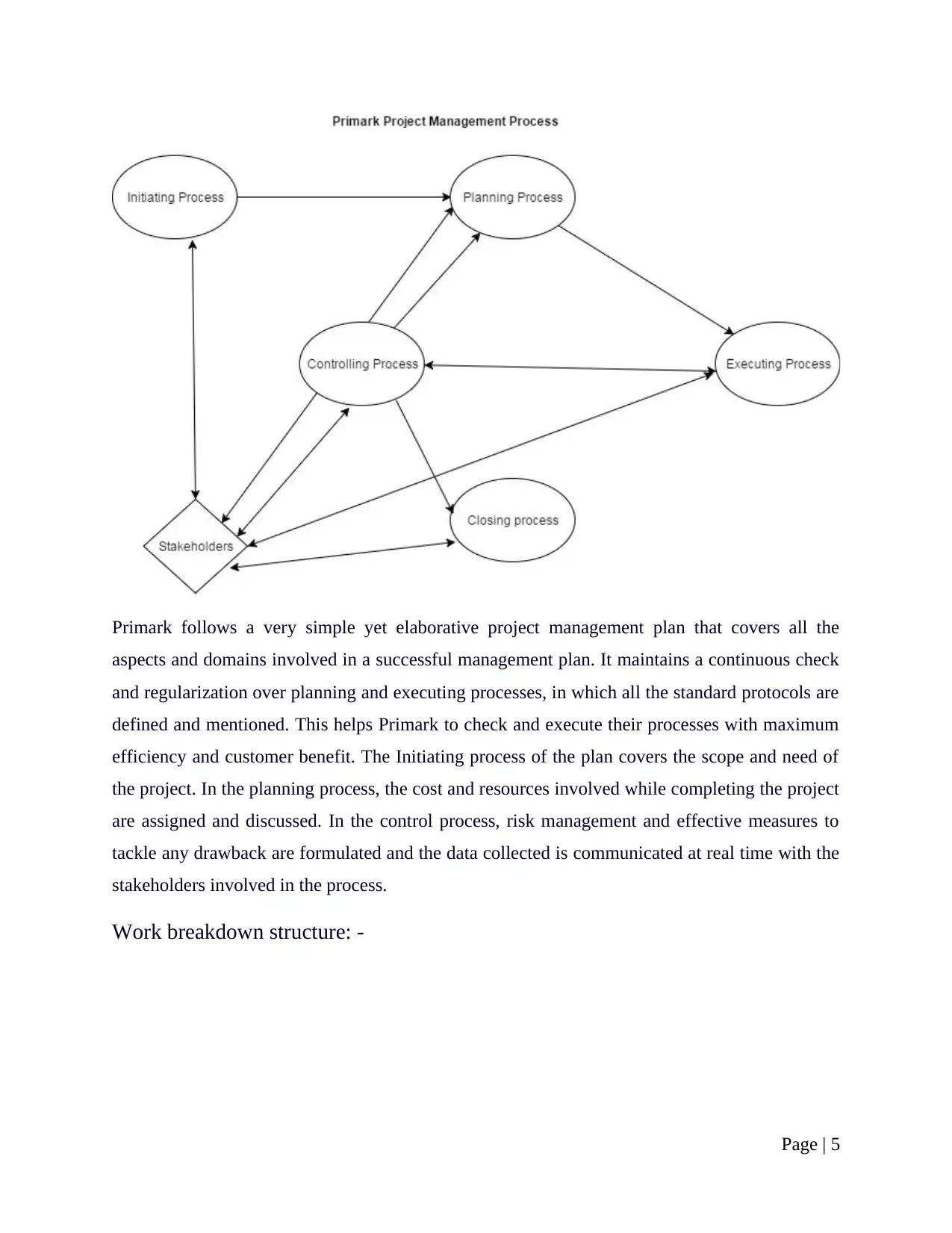
Primark follows a very simple yet elaborative project management plan that covers all the
aspects and domains involved in a successful management plan. It maintains a continuous check
and regularization over planning and executing processes, in which all the standard protocols are
defined and mentioned. This helps Primark to check and execute their processes with maximum
efficiency and customer benefit. The Initiating process of the plan covers the scope and need of
the project. In the planning process, the cost and resources involved while completing the project
are assigned and discussed. In the control process, risk management and effective measures to
tackle any drawback are formulated and the data collected is communicated at real time with the
stakeholders involved in the process.
Work breakdown structure: -
Page | 5
aspects and domains involved in a successful management plan. It maintains a continuous check
and regularization over planning and executing processes, in which all the standard protocols are
defined and mentioned. This helps Primark to check and execute their processes with maximum
efficiency and customer benefit. The Initiating process of the plan covers the scope and need of
the project. In the planning process, the cost and resources involved while completing the project
are assigned and discussed. In the control process, risk management and effective measures to
tackle any drawback are formulated and the data collected is communicated at real time with the
stakeholders involved in the process.
Work breakdown structure: -
Page | 5
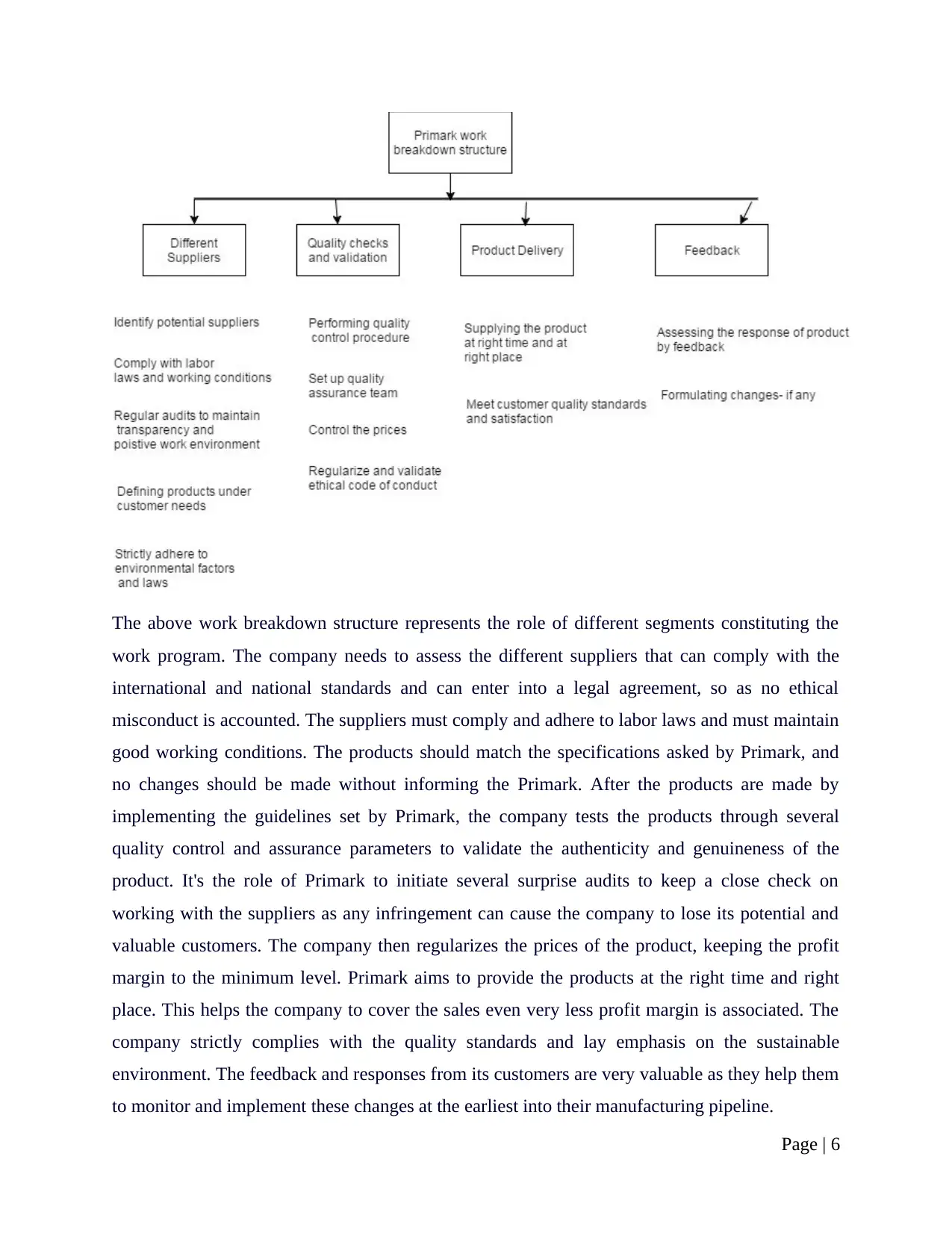
The above work breakdown structure represents the role of different segments constituting the
work program. The company needs to assess the different suppliers that can comply with the
international and national standards and can enter into a legal agreement, so as no ethical
misconduct is accounted. The suppliers must comply and adhere to labor laws and must maintain
good working conditions. The products should match the specifications asked by Primark, and
no changes should be made without informing the Primark. After the products are made by
implementing the guidelines set by Primark, the company tests the products through several
quality control and assurance parameters to validate the authenticity and genuineness of the
product. It's the role of Primark to initiate several surprise audits to keep a close check on
working with the suppliers as any infringement can cause the company to lose its potential and
valuable customers. The company then regularizes the prices of the product, keeping the profit
margin to the minimum level. Primark aims to provide the products at the right time and right
place. This helps the company to cover the sales even very less profit margin is associated. The
company strictly complies with the quality standards and lay emphasis on the sustainable
environment. The feedback and responses from its customers are very valuable as they help them
to monitor and implement these changes at the earliest into their manufacturing pipeline.
Page | 6
work program. The company needs to assess the different suppliers that can comply with the
international and national standards and can enter into a legal agreement, so as no ethical
misconduct is accounted. The suppliers must comply and adhere to labor laws and must maintain
good working conditions. The products should match the specifications asked by Primark, and
no changes should be made without informing the Primark. After the products are made by
implementing the guidelines set by Primark, the company tests the products through several
quality control and assurance parameters to validate the authenticity and genuineness of the
product. It's the role of Primark to initiate several surprise audits to keep a close check on
working with the suppliers as any infringement can cause the company to lose its potential and
valuable customers. The company then regularizes the prices of the product, keeping the profit
margin to the minimum level. Primark aims to provide the products at the right time and right
place. This helps the company to cover the sales even very less profit margin is associated. The
company strictly complies with the quality standards and lay emphasis on the sustainable
environment. The feedback and responses from its customers are very valuable as they help them
to monitor and implement these changes at the earliest into their manufacturing pipeline.
Page | 6
⊘ This is a preview!⊘
Do you want full access?
Subscribe today to unlock all pages.

Trusted by 1+ million students worldwide
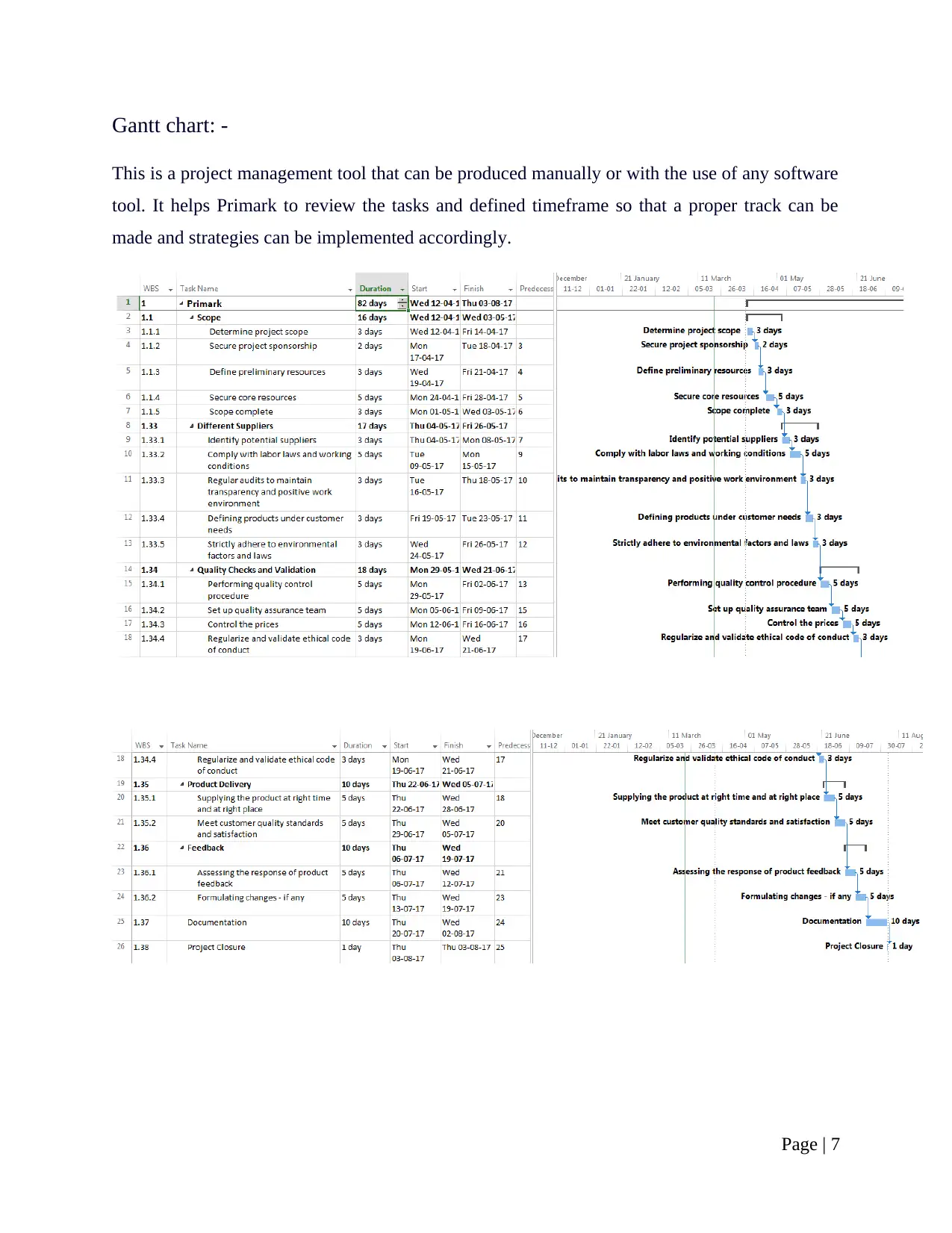
Gantt chart: -
This is a project management tool that can be produced manually or with the use of any software
tool. It helps Primark to review the tasks and defined timeframe so that a proper track can be
made and strategies can be implemented accordingly.
Page | 7
This is a project management tool that can be produced manually or with the use of any software
tool. It helps Primark to review the tasks and defined timeframe so that a proper track can be
made and strategies can be implemented accordingly.
Page | 7
Paraphrase This Document
Need a fresh take? Get an instant paraphrase of this document with our AI Paraphraser
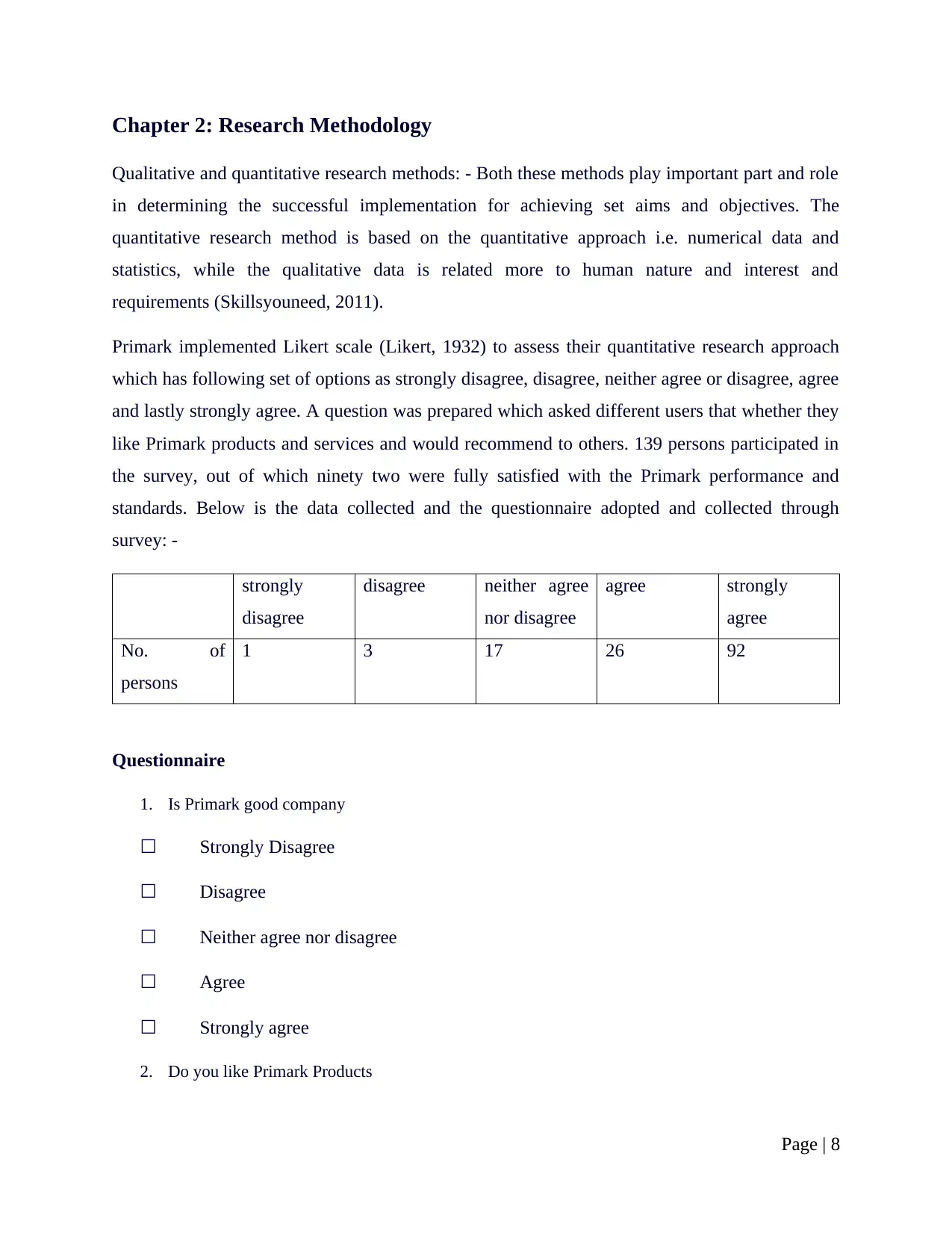
Chapter 2: Research Methodology
Qualitative and quantitative research methods: - Both these methods play important part and role
in determining the successful implementation for achieving set aims and objectives. The
quantitative research method is based on the quantitative approach i.e. numerical data and
statistics, while the qualitative data is related more to human nature and interest and
requirements (Skillsyouneed, 2011).
Primark implemented Likert scale (Likert, 1932) to assess their quantitative research approach
which has following set of options as strongly disagree, disagree, neither agree or disagree, agree
and lastly strongly agree. A question was prepared which asked different users that whether they
like Primark products and services and would recommend to others. 139 persons participated in
the survey, out of which ninety two were fully satisfied with the Primark performance and
standards. Below is the data collected and the questionnaire adopted and collected through
survey: -
strongly
disagree
disagree neither agree
nor disagree
agree strongly
agree
No. of
persons
1 3 17 26 92
Questionnaire
1. Is Primark good company
☐ Strongly Disagree
☐ Disagree
☐ Neither agree nor disagree
☐ Agree
☐ Strongly agree
2. Do you like Primark Products
Page | 8
Qualitative and quantitative research methods: - Both these methods play important part and role
in determining the successful implementation for achieving set aims and objectives. The
quantitative research method is based on the quantitative approach i.e. numerical data and
statistics, while the qualitative data is related more to human nature and interest and
requirements (Skillsyouneed, 2011).
Primark implemented Likert scale (Likert, 1932) to assess their quantitative research approach
which has following set of options as strongly disagree, disagree, neither agree or disagree, agree
and lastly strongly agree. A question was prepared which asked different users that whether they
like Primark products and services and would recommend to others. 139 persons participated in
the survey, out of which ninety two were fully satisfied with the Primark performance and
standards. Below is the data collected and the questionnaire adopted and collected through
survey: -
strongly
disagree
disagree neither agree
nor disagree
agree strongly
agree
No. of
persons
1 3 17 26 92
Questionnaire
1. Is Primark good company
☐ Strongly Disagree
☐ Disagree
☐ Neither agree nor disagree
☐ Agree
☐ Strongly agree
2. Do you like Primark Products
Page | 8
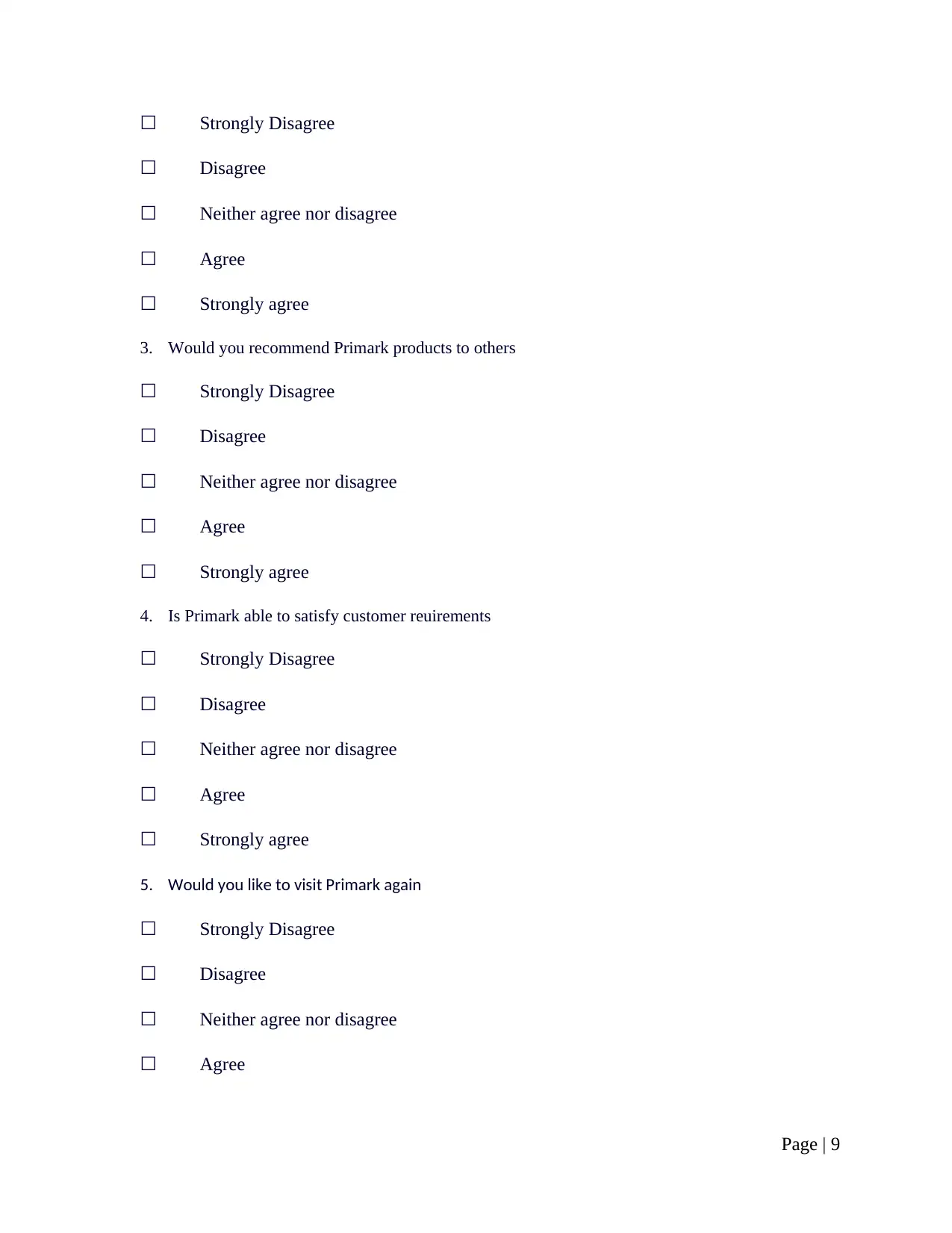
☐ Strongly Disagree
☐ Disagree
☐ Neither agree nor disagree
☐ Agree
☐ Strongly agree
3. Would you recommend Primark products to others
☐ Strongly Disagree
☐ Disagree
☐ Neither agree nor disagree
☐ Agree
☐ Strongly agree
4. Is Primark able to satisfy customer reuirements
☐ Strongly Disagree
☐ Disagree
☐ Neither agree nor disagree
☐ Agree
☐ Strongly agree
5. Would you like to visit Primark again
☐ Strongly Disagree
☐ Disagree
☐ Neither agree nor disagree
☐ Agree
Page | 9
☐ Disagree
☐ Neither agree nor disagree
☐ Agree
☐ Strongly agree
3. Would you recommend Primark products to others
☐ Strongly Disagree
☐ Disagree
☐ Neither agree nor disagree
☐ Agree
☐ Strongly agree
4. Is Primark able to satisfy customer reuirements
☐ Strongly Disagree
☐ Disagree
☐ Neither agree nor disagree
☐ Agree
☐ Strongly agree
5. Would you like to visit Primark again
☐ Strongly Disagree
☐ Disagree
☐ Neither agree nor disagree
☐ Agree
Page | 9
⊘ This is a preview!⊘
Do you want full access?
Subscribe today to unlock all pages.

Trusted by 1+ million students worldwide
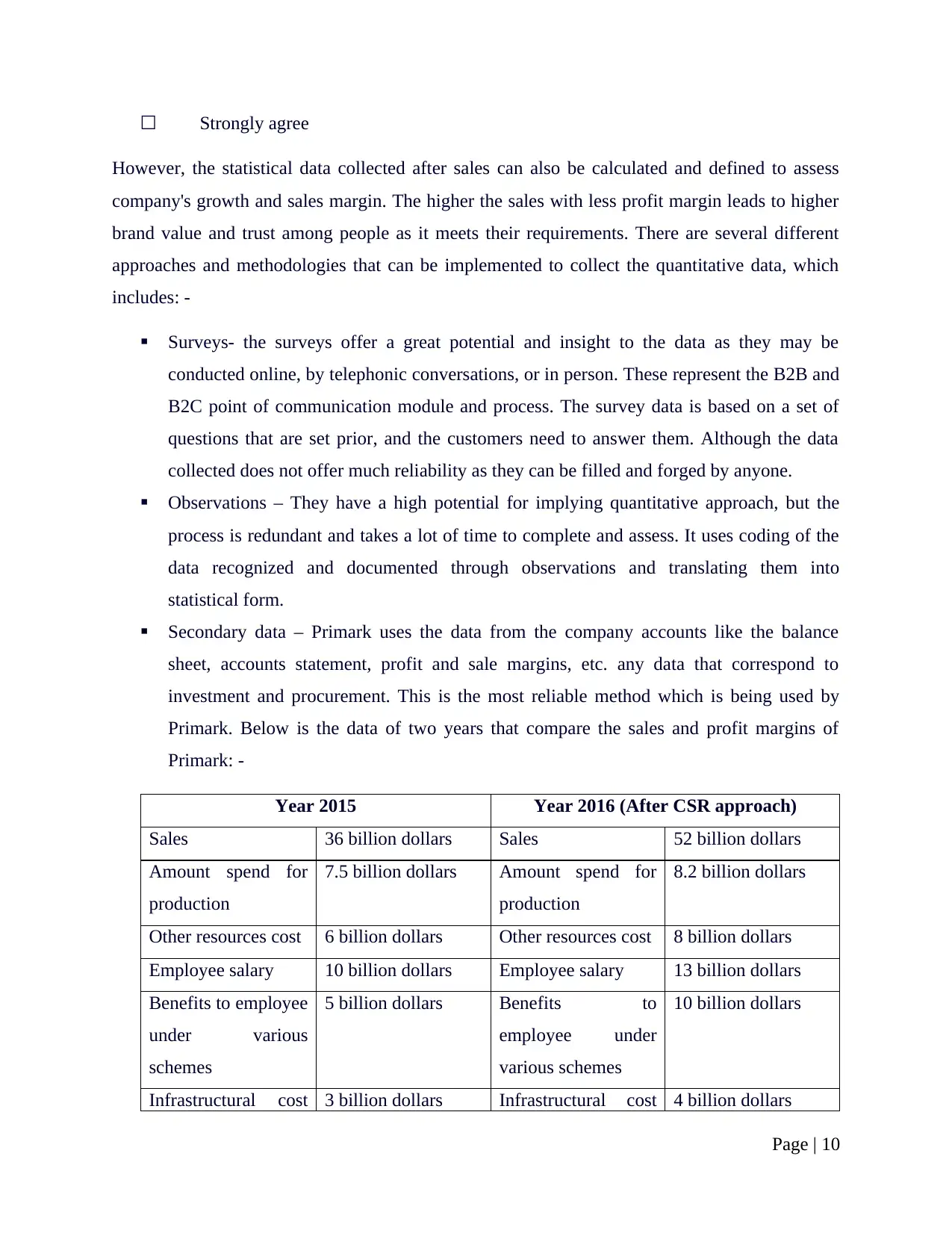
☐ Strongly agree
However, the statistical data collected after sales can also be calculated and defined to assess
company's growth and sales margin. The higher the sales with less profit margin leads to higher
brand value and trust among people as it meets their requirements. There are several different
approaches and methodologies that can be implemented to collect the quantitative data, which
includes: -
Surveys- the surveys offer a great potential and insight to the data as they may be
conducted online, by telephonic conversations, or in person. These represent the B2B and
B2C point of communication module and process. The survey data is based on a set of
questions that are set prior, and the customers need to answer them. Although the data
collected does not offer much reliability as they can be filled and forged by anyone.
Observations – They have a high potential for implying quantitative approach, but the
process is redundant and takes a lot of time to complete and assess. It uses coding of the
data recognized and documented through observations and translating them into
statistical form.
Secondary data – Primark uses the data from the company accounts like the balance
sheet, accounts statement, profit and sale margins, etc. any data that correspond to
investment and procurement. This is the most reliable method which is being used by
Primark. Below is the data of two years that compare the sales and profit margins of
Primark: -
Year 2015 Year 2016 (After CSR approach)
Sales 36 billion dollars Sales 52 billion dollars
Amount spend for
production
7.5 billion dollars Amount spend for
production
8.2 billion dollars
Other resources cost 6 billion dollars Other resources cost 8 billion dollars
Employee salary 10 billion dollars Employee salary 13 billion dollars
Benefits to employee
under various
schemes
5 billion dollars Benefits to
employee under
various schemes
10 billion dollars
Infrastructural cost 3 billion dollars Infrastructural cost 4 billion dollars
Page | 10
However, the statistical data collected after sales can also be calculated and defined to assess
company's growth and sales margin. The higher the sales with less profit margin leads to higher
brand value and trust among people as it meets their requirements. There are several different
approaches and methodologies that can be implemented to collect the quantitative data, which
includes: -
Surveys- the surveys offer a great potential and insight to the data as they may be
conducted online, by telephonic conversations, or in person. These represent the B2B and
B2C point of communication module and process. The survey data is based on a set of
questions that are set prior, and the customers need to answer them. Although the data
collected does not offer much reliability as they can be filled and forged by anyone.
Observations – They have a high potential for implying quantitative approach, but the
process is redundant and takes a lot of time to complete and assess. It uses coding of the
data recognized and documented through observations and translating them into
statistical form.
Secondary data – Primark uses the data from the company accounts like the balance
sheet, accounts statement, profit and sale margins, etc. any data that correspond to
investment and procurement. This is the most reliable method which is being used by
Primark. Below is the data of two years that compare the sales and profit margins of
Primark: -
Year 2015 Year 2016 (After CSR approach)
Sales 36 billion dollars Sales 52 billion dollars
Amount spend for
production
7.5 billion dollars Amount spend for
production
8.2 billion dollars
Other resources cost 6 billion dollars Other resources cost 8 billion dollars
Employee salary 10 billion dollars Employee salary 13 billion dollars
Benefits to employee
under various
schemes
5 billion dollars Benefits to
employee under
various schemes
10 billion dollars
Infrastructural cost 3 billion dollars Infrastructural cost 4 billion dollars
Page | 10
Paraphrase This Document
Need a fresh take? Get an instant paraphrase of this document with our AI Paraphraser
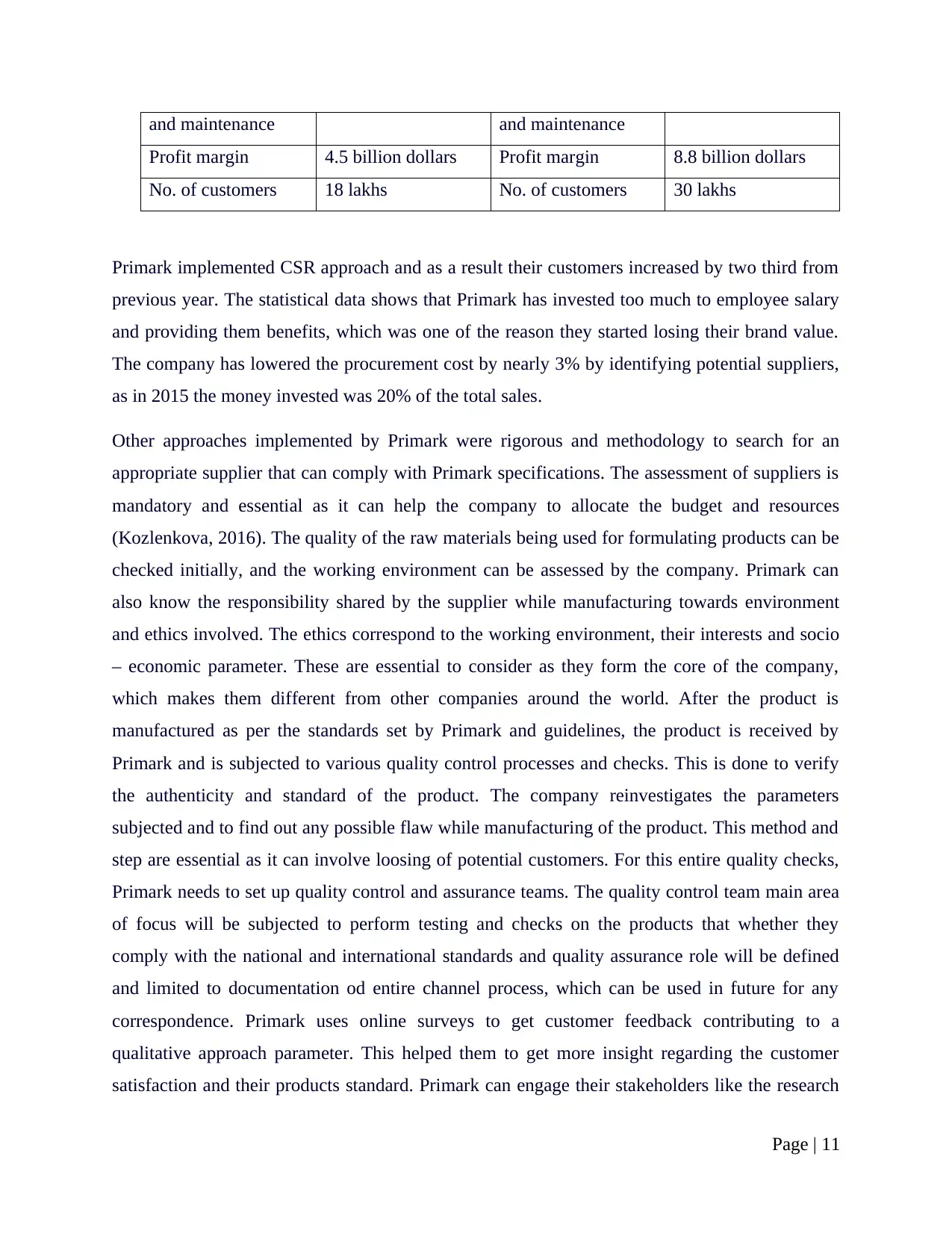
and maintenance and maintenance
Profit margin 4.5 billion dollars Profit margin 8.8 billion dollars
No. of customers 18 lakhs No. of customers 30 lakhs
Primark implemented CSR approach and as a result their customers increased by two third from
previous year. The statistical data shows that Primark has invested too much to employee salary
and providing them benefits, which was one of the reason they started losing their brand value.
The company has lowered the procurement cost by nearly 3% by identifying potential suppliers,
as in 2015 the money invested was 20% of the total sales.
Other approaches implemented by Primark were rigorous and methodology to search for an
appropriate supplier that can comply with Primark specifications. The assessment of suppliers is
mandatory and essential as it can help the company to allocate the budget and resources
(Kozlenkova, 2016). The quality of the raw materials being used for formulating products can be
checked initially, and the working environment can be assessed by the company. Primark can
also know the responsibility shared by the supplier while manufacturing towards environment
and ethics involved. The ethics correspond to the working environment, their interests and socio
– economic parameter. These are essential to consider as they form the core of the company,
which makes them different from other companies around the world. After the product is
manufactured as per the standards set by Primark and guidelines, the product is received by
Primark and is subjected to various quality control processes and checks. This is done to verify
the authenticity and standard of the product. The company reinvestigates the parameters
subjected and to find out any possible flaw while manufacturing of the product. This method and
step are essential as it can involve loosing of potential customers. For this entire quality checks,
Primark needs to set up quality control and assurance teams. The quality control team main area
of focus will be subjected to perform testing and checks on the products that whether they
comply with the national and international standards and quality assurance role will be defined
and limited to documentation od entire channel process, which can be used in future for any
correspondence. Primark uses online surveys to get customer feedback contributing to a
qualitative approach parameter. This helped them to get more insight regarding the customer
satisfaction and their products standard. Primark can engage their stakeholders like the research
Page | 11
Profit margin 4.5 billion dollars Profit margin 8.8 billion dollars
No. of customers 18 lakhs No. of customers 30 lakhs
Primark implemented CSR approach and as a result their customers increased by two third from
previous year. The statistical data shows that Primark has invested too much to employee salary
and providing them benefits, which was one of the reason they started losing their brand value.
The company has lowered the procurement cost by nearly 3% by identifying potential suppliers,
as in 2015 the money invested was 20% of the total sales.
Other approaches implemented by Primark were rigorous and methodology to search for an
appropriate supplier that can comply with Primark specifications. The assessment of suppliers is
mandatory and essential as it can help the company to allocate the budget and resources
(Kozlenkova, 2016). The quality of the raw materials being used for formulating products can be
checked initially, and the working environment can be assessed by the company. Primark can
also know the responsibility shared by the supplier while manufacturing towards environment
and ethics involved. The ethics correspond to the working environment, their interests and socio
– economic parameter. These are essential to consider as they form the core of the company,
which makes them different from other companies around the world. After the product is
manufactured as per the standards set by Primark and guidelines, the product is received by
Primark and is subjected to various quality control processes and checks. This is done to verify
the authenticity and standard of the product. The company reinvestigates the parameters
subjected and to find out any possible flaw while manufacturing of the product. This method and
step are essential as it can involve loosing of potential customers. For this entire quality checks,
Primark needs to set up quality control and assurance teams. The quality control team main area
of focus will be subjected to perform testing and checks on the products that whether they
comply with the national and international standards and quality assurance role will be defined
and limited to documentation od entire channel process, which can be used in future for any
correspondence. Primark uses online surveys to get customer feedback contributing to a
qualitative approach parameter. This helped them to get more insight regarding the customer
satisfaction and their products standard. Primark can engage their stakeholders like the research
Page | 11
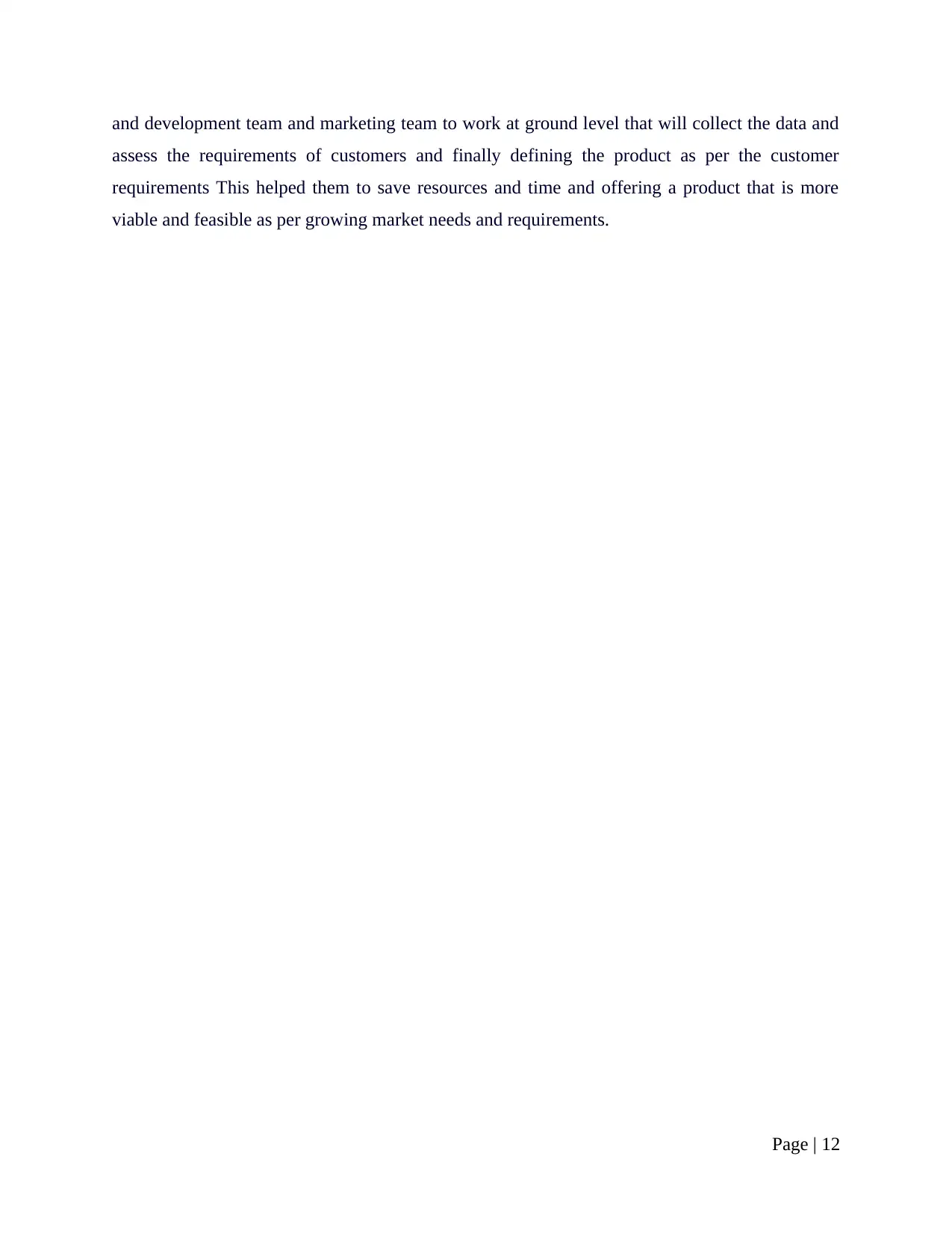
and development team and marketing team to work at ground level that will collect the data and
assess the requirements of customers and finally defining the product as per the customer
requirements This helped them to save resources and time and offering a product that is more
viable and feasible as per growing market needs and requirements.
Page | 12
assess the requirements of customers and finally defining the product as per the customer
requirements This helped them to save resources and time and offering a product that is more
viable and feasible as per growing market needs and requirements.
Page | 12
⊘ This is a preview!⊘
Do you want full access?
Subscribe today to unlock all pages.

Trusted by 1+ million students worldwide
1 out of 20
Related Documents
Your All-in-One AI-Powered Toolkit for Academic Success.
+13062052269
info@desklib.com
Available 24*7 on WhatsApp / Email
![[object Object]](/_next/static/media/star-bottom.7253800d.svg)
Unlock your academic potential
Copyright © 2020–2025 A2Z Services. All Rights Reserved. Developed and managed by ZUCOL.




